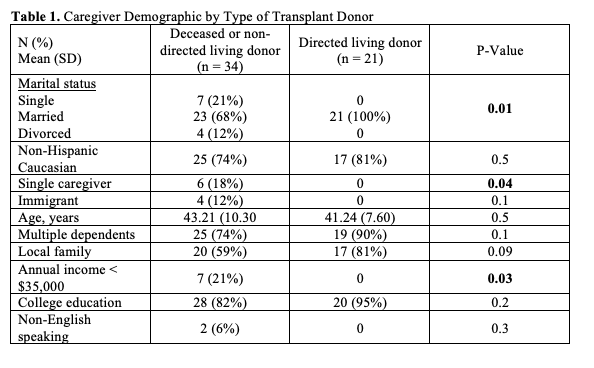Socioeconomic Factors Influence Likelihood of Directed Living Donor Transplant Among Children with End-Stage Renal or Liver Disease
University of Colorado Anschutz Medical, Aurora, CO
Meeting: 2022 American Transplant Congress
Abstract number: 1198
Keywords: Kidney, Liver, Living donor, Pediatric
Topic: Clinical Science » Organ Inclusive » 70 - Non-Organ Specific: Disparities to Outcome and Access to Healthcare
Session Information
Session Name: Non-Organ Specific: Disparities to Outcome and Access to Healthcare
Session Type: Poster Abstract
Date: Sunday, June 5, 2022
Session Time: 7:00pm-8:00pm
 Presentation Time: 7:00pm-8:00pm
Presentation Time: 7:00pm-8:00pm
Location: Hynes Halls C & D
*Purpose: Previous studies have demonstrated that children with public insurance are less likely to receive a transplant from a directed living donor. Type of insurance is commonly used as a proxy for socioeconomic status due to limited social and demographic data available in national transplant databases. This study was designed to address the lack of demographic data and to further investigate which socioeconomic factors influence the likelihood of a directed living donor transplant among pediatric kidney and liver transplant candidates.
*Methods: This study was approved by COMIRB (#21-2991). An online questionnaire was sent out to the primary caregivers of all pediatric (age < 18) kidney and liver transplant recipients transplanted or followed at our institution from February 2015 through August 2021. The primary outcome of interest was receiving a transplant from a directed living donor (DLD) vs. a deceased donor or a non-directed donor (NDD). Categorical data are compared with the Chi-square test and continuous data with the Student’s t-test.
*Results: Out of 244 invitations, 55 (23%) primary caregivers completed the questionnaire, representing 25 liver and 30 kidney pediatric transplant recipients. 21 (38%) of the recipients received a transplant from a directed living donor. Caregivers of DLD recipients were more commonly married in comparison to caregivers of NDD recipients (100% vs. 68%, p = 0.01). 18% of NDD recipients had a single caregiver, while none of the DLD recipients had single caregiver (p = 0.04). 21% of caregivers of NDD recipients had a household annual income < $35,000, while all the DLD recipients came from a household with an annual income higher than $35,000 (p = 0.03).
*Conclusions: Pediatric liver and kidney transplant recipients of a directed living donor were significantly more likely to come from a household with multiple caregivers and higher income. Future initiatives must focus on increasing access to living donation to single parent households and mitigate the financial expense of living donation. Ongoing qualitative research will expand our understanding of these barriers and how they may best be addressed.
To cite this abstract in AMA style:
Yoeli D, Mathai S, O'Neill C, Lamberty E, Kaar J, Mata C, Feldman A, Bock M, Jackson W, Adams M. Socioeconomic Factors Influence Likelihood of Directed Living Donor Transplant Among Children with End-Stage Renal or Liver Disease [abstract]. Am J Transplant. 2022; 22 (suppl 3). https://atcmeetingabstracts.com/abstract/socioeconomic-factors-influence-likelihood-of-directed-living-donor-transplant-among-children-with-end-stage-renal-or-liver-disease/. Accessed January 7, 2026.« Back to 2022 American Transplant Congress

